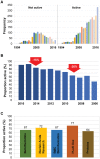A snapshot of 3649 Web-based services published between 1994 and 2017 shows a decrease in availability after 2 years
- PMID: 29228189
- PMCID: PMC6585384
- DOI: 10.1093/bib/bbx159
A snapshot of 3649 Web-based services published between 1994 and 2017 shows a decrease in availability after 2 years
Abstract
Background: The long-term availability of online Web services is of utmost importance to ensure reproducibility of analytical results. However, because of lack of maintenance following acceptance, many servers become unavailable after a short period of time. Our aim was to monitor the accessibility and the decay rate of published Web services as well as to determine the factors underlying trends changes.
Methods: We searched PubMed to identify publications containing Web server-related terms published between 1994 and 2017. Automatic and manual screening was used to check the status of each Web service. Kruskall-Wallis, Mann-Whitney and Chi-square tests were used to evaluate various parameters, including availability, accessibility, platform, origin of authors, citation, journal impact factor and publication year.
Results: We identified 3649 publications in 375 journals of which 2522 (69%) were currently active. Over 95% of sites were running in the first 2 years, but this rate dropped to 84% in the third year and gradually sank afterwards (P < 1e-16). The mean half-life of Web services is 10.39 years. Working Web services were published in journals with higher impact factors (P = 4.8e-04). Services published before the year 2000 received minimal attention. The citation of offline services was less than for those online (P = 0.022). The majority of Web services provide analytical tools, and the proportion of databases is slowly decreasing. Conclusions. Almost one-third of Web services published to date went out of service. We recommend continued support of Web-based services to increase the reproducibility of published results.
Keywords: Web servers; Web services; bioinformatics tools; citation analysis; databases; online.
© The Author 2017. Published by Oxford University Press.
Figures




References
-
- Further confirmation needed. Nat Biotechnol 2012; 30:806. - PubMed
Publication types
MeSH terms
LinkOut - more resources
Full Text Sources
Other Literature Sources

